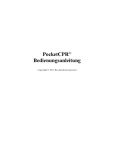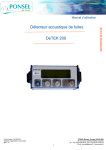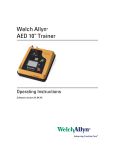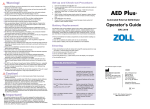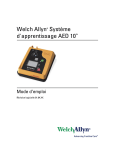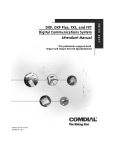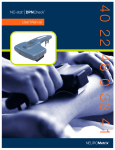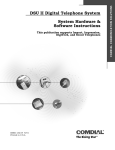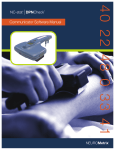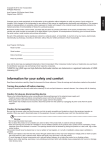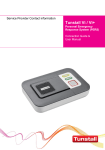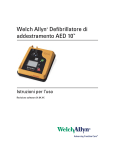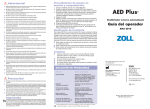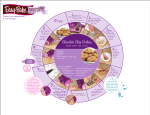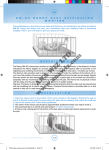Download Cover Page - CRS Medical
Transcript
PocketCPR® User’s Manual Copyright © 2011 Bio-Detek Incorporated Introduction Effective cardiopulmonary resuscitation (CPR), when administered quickly after the on-set of cardiac arrest, is effective at saving lives and enabling complete neurological recovery, especially when followed by early defibrillation. The PocketCPR® was developed to provide users with real-time feedback during the administration of CPR, to assist CPR instructors during class exercises, and to provide CPR students with verbal instructions and feedback for at-home practice. When the PocketCPR is turned on, the device reminds the user to call for help. Once placed on the patient’s chest and chest compressions have begun, PocketCPR generates a metronome at the recommended rate of chest compression, gives verbal and visual feedback on the quality of CPR being delivered and reminds the user to give two breaths after every 30 compressions. Measurement of actual chest wall movement is made by a state-of-theart accelerometer micro-chip and microprocessor performing continuous analysis. CAUTIONS CPR is best performed by trained rescuers. It is advised that all users of PocketCPR obtain CPR training from a certified CPR training organization upon purchase of the PocketCPR. A local training organization may be found in your local phone directory (under CPR or First Aid Training). PocketCPR may be used without training. However, training prior to use may improve performance during rescue efforts. R2132-02 Rev. C 22.08.2011 Page 1 Use PocketCPR only as described in this manual. Use PocketCPR only on patients determined to be unresponsive and not breathing. PocketCPR is designed for use on individuals greater than 1 year old, not for use on Infants. Users of PocketCPR should become familiar with the operation of the PocketCPR prior to its application in a real rescue. Use only Duracell Ultra123A lithium batteries. Discard batteries properly after removal from unit. If the device is stored outside the recommended environmental conditions, the batteries may be damaged or their useful life reduced. If PocketCPR should malfunction during use, continue to administer CPR (with or without PocketCPR on the patients’ chest). Indications for Use To assist users in the performance of effective CPR on Children greater than 1 year old and Adults. Contraindications for Use Do NOT use the PocketCPR when the patient: Is conscious; or Is breathing normally; or (NOTE: agonal, or gasping breaths are not normal) Is less than one (1) year old R2132-02 Rev. C Page 2 Intended Use of the Device PocketCPR is intended to assist users in the performance of CPR. It is strongly recommended that users have training in CPR. The PocketCPR provides a metronome designed to encourage users to perform chest compressions at the AHA/ERC 2010 Guidelines recommended rate of at least 100 compressions per minute. Voice and visual prompts encourage a compression depth of at least 2 inches (5 cm) for Children greater than 1 year old and Adults. Notification of Adverse Events If you are a health care provider, you may have responsibilities under the Safe Medical Device Act (SMDA) for reporting to Bio-Detek and, possibly to the FDA and/or National Authorities, the occurrence of adverse events. These events, described in 21 CFR Part 803, include device-related death and serious injury or illness. In any event, as part of our Quality Assurance Program, Bio-Detek should be notified of any device failures or malfunction. This information is required to assure that Bio-Detek provides only the highest quality products. Symbols used: See accompanying documents/ User’s Manual CE labeling according to Council-Directive 93/42/EEC by the manufacturer. At the end of the lifecycle of PocketCPR please dispose of all parts according to your local laws and regulations for disposal and recycling. Prior to disposal please clean and disinfect the apparatus. Latex Free Do not use on Neonates/Infants 1 year or less For use on Children greater than 1 year and Adults Patient Side R2132-02 Rev. C Page 3 Theory of Operation The PocketCPR operation is based on the same technology as that found in the ZOLL AED Plus® and ZOLL AED Pro®. The PocketCPR directly measures acceleration through the use of an integrated accelerometer and instantaneously derives displacement. If the user is not compressing the chest at least 2 inches (5 cm), the PocketCPR will instruct them to increase compression depth. The rate of compression is prompted by the use of a metronome signal, encouraging the user to keep pace with the PocketCPR audible tone. After 30 compressions or about 18 seconds of chest compressions, PocketCPR will instruct the user to give two breaths. PocketCPR is about the size of a small cellular phone, oblong in shape and battery-powered. The device is placed on a patient's chest with or without an adhesive pad (described under Accessories); the user’s hands are placed directly on top of the device and, after chest compressions are started, the device produces audible beeps and lights (LEDs) flashing at a rate of 100 compressions per minute. If the user’s compressions are averaging less than 2 inches or 5 cm, after 4 seconds, the device will prompt the user to “PUSH HARDER”. If compressions are adequate, after approximately ten seconds, the device prompts “GOOD COMPRESSIONS”. After approximately eighteen seconds of chest compressions (30 compressions), the device will remind the user to ventilate the patient with the message, “OPEN AIRWAY, GIVE TWO BREATHS”. If the rescuer chooses to NOT ventilate the patient and continues delivering chest compressions, PocketCPR will advance forward and provide standard visual and audio feedback after approximately 3 compressions. R2132-02 Rev. C Page 4 INSTRUCTIONS FOR USE Call your Emergency Response number (911 in USA, 999, or 112 or varied numbers elsewhere) immediately if you think you have encountered a medical emergency. Calling for help is the first step in the life-saving process. If other individuals are available, instruct them to call for help and find an AED. Keep the rescue scene clear and controlled while you begin to rescue the patient. As a rescuer, committed to a patient, you are strongly urged to stay with the patient and to continue rescue efforts until emergency medical personnel arrive. Once emergency medical personnel do arrive, a description of the occurrence and your rescue efforts will be valuable information to communicate. NORMAL OPERATING MODE Start-Up 1. 2. 3. 4. 5. 6. Power On the device by pressing the rubber power button on the side of PocketCPR (marked with a circle and vertical line in the middle). Allow device to Power Up and perform its system checks. Place device in the center of the chest as shown on label. Follow the verbal prompts to: “STAY CALM” “CHECK RESPONSIVENESS” “CALL FOR HELP” “OPEN AIRWAY” “CHECK BREATHING” "START CPR" Place the heel of one hand on the device and the second hand on top so both hands are overlapped. Begin chest compressions, allow for “Full Release” on “UP” stroke. R2132-02 Rev. C Page 5 7. After 18 seconds, representing 30 compressions, follow the verbal prompts to: “OPEN AIRWAY” “GIVE TWO BREATHS” 8. Continue CPR chest compressions following the metronome and light prompts to ensure proper depth and rate. Cycles of 30 compressions and 2 ventilations are recommended or continuous chest compressions if you are unwilling or unable to provide ventilations, or if an advanced airway has been secured. Operational Notes 1. The metronome rate will be 100 compressions per minute. 2. Insufficient compressions will be indicated by one single LED light flashing and an audio prompt to “PUSH HARDER” every 4 seconds. Adequate compressions will be indicated by all four LED lights flashing and a “GOOD COMPRESSIONS” audio prompt every 9 seconds. 3. 4. “OPEN AIRWAY, GIVE TWO BREATHS” will be prompted every 18 seconds after the start of chest compressions. The device will allow 6 seconds for the delivery of two breaths and then will restart the flashing and audible beeping of the metronome. 5. These messages will continue to recycle until the unit is turned off by pushing the power button for 3 full seconds. R2132-02 Rev. C Page 6 SILENT MODE Start-Up 1. Power On the device by pressing and holding in the power button on the side of the device. After hearing the verbal prompt, “STAY CALM.”, wait a full second before releasing the power button. 2. The device metronome will begin to flash, indicating that the device is ready for CPR to begin, allow for “Full Release” on “UP” stroke. Operational Notes 1. The metronome rate will be 100 compressions per minute. 2. Insufficient compressions will be indicated by one single LED light flashing. 3. Adequate compressions will be indicated by all four LED lights flashing. 4. The user must count their compressions, as the device will not pause for ventilations. When the user pauses for ventilations, the metronome will continue to flash at 100 compressions per minute and wait for compressions to restart. 5. The unit can be turned off by holding down the power button for 3 full seconds. R2132-02 Rev. C Page 7 CHEST COMPRESSION ONLY MODE (FAST FORWARD FEATURE) 1. After powering on the device, if the user is compressing at an adequate depth for several seconds the device will jump ahead (or fast forward) to the “Start CPR” message, play the metronome and provide feedback on chest compression depth, allow for “Full Release” on “UP” stroke. 2. After playing the “Open Airway, Give two Breaths” message if the user is compressing at an adequate depth for 3-4 seconds the device will jump ahead to the “Start CPR” message, play the metronome and provide feedback on chest compression depth. AED MODE (for use with an Automatic External Defibrillator) 1. PocketCPR used in conjunction with an AED, allows the user to temporarily shut off all verbal prompts from the PocketCPR device. Turning PocketCPR upside down (speaker facing down toward patient), causes all verbal messages to stop. When inverted to right side up (speaker facing up – away from patient), the message “Start CPR” will be played and all verbal prompts are turned on once compressions are detected. 2. The voice message "ANALYSIS HALTED" will play to indicate the unit is not providing CPR feedback in the inverted position. The "Patient Side" label will be visible on the underside of the device, when inverted in AED Mode. Once the unit is re-inverted to the therapy position, CPR feedback will resume. 3. Allow for full release on “UP” stroke. 4. Chest compressions should not be performed on PocketCPR while the unit is inverted. R2132-02 Rev. C Page 8 ACCESSORIES: Adhesive Label (Reorder # 2030) Adhesive labels are available to use for sticking PocketCPR to either a patient or to a manikin. Instructions for Use: Remove the backing paper from the Adhesive Label. Apply label to back of PocketCPR and push firmly to adhere the adhesive surface properly When ready to apply PocketCPR to patient or manikin, remove the label face by grasping at the tab at the TOP A sticky layer of adhesive will remain on the back surface of PocketCPR which will adhere PocketCPR to the patient’s chest or to a manikin. After removal of PocketCPR from the patient or manikin, the sticky layer of adhesive can be easily removed from PocketCPR by simply peeling it away or rolling it off with firm pressure from your thumb or finger Silicone protective boot cover (Reorder # 2094) A clear, silicone, protective cover is available that prevents moisture and bodily fluids from entering the speaker area. Technical Data: RoHS Compliant Dimensions: 4 ½" x 2" x 1" (10.5cm x 5.1cm x 2.5cm) Weight: 2.9 oz., (82g) R2132-02 Rev. C Page 9 Storage/Operating Temperature Ambient/Operating Temperature: 0◦ C to 50◦ C (32◦ F to 122◦ F) Storage Temperature: -30◦ C to 65◦ C (-22◦ F to 149◦ F) Relative Humidity Range: 30% to 75% Atmospheric Pressure Range: 700hPa to 1,060 hPa This device is not suitable for operation in AP and APG applications (Flammable anesthetic mixture with air or with oxygen or nitrous oxide). PocketCPR does not usually cause electromagnetic interference with other devices. Should a problem occur try moving the device further away. If the problem persists turn the PocketCPR device off. PRODUCT WARRANTY BIO-DETEK Incorporated (BIO-DETEK) warrants to the Customer that from the date of receipt by customer, new PocketCPR’s will be free from defects in material and workmanship under normal use and service for a period of five (5) years. During such period BIO-DETEK will at no charge to the Customer, either repair or replace (at BIODETEK’s sole option) any part of the device found to be defective in material or workmanship. If BIO-DETEK’s inspection detects no defects in material or workmanship, BIO-DETEK’s regular service charges shall apply. Except as set forth above, BIO-DETEK shall not be responsible for any Product defect, the failure of the Product to perform any specified function, or any other nonconformance of the Product caused by or attributable to: (i) any modification of the Product by the Customer, unless such modification is made with the prior written approval of BIO-DETEK; (ii) the use of the equipment with any associated or R2132-02 Rev. C Page 10 complementary equipment, accessory or software not supplied, specified or approved by BIO-DETEK; (iii) any misuse or abuse of the equipment by Customer; (iv) exposure of the Product to conditions beyond the environmental, power or operating constraints specified by BIO-DETEK; or (v) installation or wiring of the Product other than in accordance with BIO-DETEK’s instructions. This warranty does not cover items subject to normal wear and burnout during use, including but not limited to lamps, fuses, batteries, and accessories. The foregoing warranty does not apply to software included as part of the Products (including software embodied in readonly memory, known as “firmware”). The foregoing warranty constitutes the exclusive remedy of the Customer and the exclusive liability of BIO-DETEK for any breach of any warranty related to the Products supplied hereunder. EXCEPT AS OTHERWISE SET FORTH IN THE AGREEMENT, THE WARRANTY SET FORTH HEREIN IS EXCLUSIVE AND BIO-DETEK EXPRESSLY DISCLAIMS ALL OTHER WARRANTIES WHETHER WRITTEN, ORAL, IMPLIED, OR STATUTORY, INCLUDING BUT NOT LIMITED TO ANY WARRANTIES OF MERCHANTABILITY OF FITNESS FOR A PARTICULAR PURPOSE. This product is covered by one or more of the following U.S. Patents: 7,074,199 7,108,665 7,220,235 R2132-02 Rev. C Page 11 CONTACT INFORMATION Bio-Detek, Incorporated A ZOLL Medical Corporation Subsidiary 525 Narragansett Park Drive Pawtucket, RI 02861-4323 Phone: 800.225.1310 Fax: 401.729.1408 Email: [email protected] ZOLL International Holding B.V. Newtonweg 18 6662 PV ELST The Netherlands Telephone: +31(0) 481 366410 Telefax: +31(0) 481 366411 ZOLL Medical U.K. Ltd. 16 Seymour Court Manor Park, Runcorn Cheshire WA7 1SY Telephone: +44-192-859-5160 Telefax: +44-192-859-5161 ZOLL Medical France Parc d’ Affaires Parkile 164 Avenue Joseph Kessel 78960 Voisins le Bretonneux FRANCE Telephone: +33 1 30 57 70 40 Telefax: +33 1 30 57 02 85 ZOLL Medical Deutschland Gmbh Emil-Hoffmann, Str. 13 50996 Cologne Germany Telephone: + 49 2236 87 87-0 Telefax: + 49 2236 87 87-77 R2132-02 Rev. C Page 12 DEVICE CLEANING AND MAINTENANCE Cleaning The PocketCPR is reusable. After each use, clean the device: Disinfect the unit with a soft, damp cloth using mild detergent and water. Do not immerse any part of the unit in water. Do not use ketones (MEK, acetone, etc.) to clean the unit. Avoid using abrasives (e.g., paper towel). Do not sterilize the device. Battery The battery with which your PocketCPR was shipped has a shelf life of 5 years. Our recommendation is to change the battery after 5 years of non-use, 10 hours of continuous use or at the prompt “Change Battery” to change battery. If this message is heard during Power Up, you may use the device for the current rescue, but you must immediately replace the battery after the rescue or if the metronome light stops flashing. To replace the battery, you will need a screwdriver. On the bottom (chest side) of the device, you will see two screws. Loosen the two screws by gently turning each of them in a counter-clockwise direction until they are fully loosened. Be careful not to lose the screws as you remove them from the housing. After the screws have been removed, gently remove the bottom cover of the PocketCPR. As you look at the circuit board, you will see a white (+) sign. The battery can be easily removed by lifting up this end of the battery. Be careful not to touch the circuit board. R2132-02 Rev. C Page 13 Replace the battery with a Duracell Ultra 123 lithium battery by inserting the negative (-) end first and then pressing down gently on the positive (+) end until the battery is firmly in place. Replace the bottom cover and screws. Tighten the screws gently by using a clockwise motion with a screwdriver. Do not over-tighten. TROUBLESHOOTING If the PocketCPR does not turn on, or if the visual or audible indicators are not working, continue CPR using manual compressions and ventilations. Once the rescue procedure is complete, replace the battery as indicated in the DEVICE CLEANING AND MAINTENANCE section. If replacement of the battery does not return the PocketCPR to normal function, call a ZOLL Medical Distribution Center. R2132-02 Rev. C Page 14
















